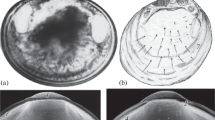Abstract
Colonies of hydroid polyps of the genus Eudendrium Ehrenberg release planula larvae with a high yolk content. Immediately after hatching, they begin to excrete a slime rope. In the presence of water movements, larvae hatching simultaneously tend to join a trail of slime; in stagnant water, the larvae move down the rope separately. The planula larvae are unable to float. On the basis of aquarium observations, we suggest that slime ropes with larvae adhere to substrates in the vicinity of the mother colony; this prevents the larvae from being carried off too far into open waters. In view of the absence of medusae in Eudendrium, this response of the planula is interpreted as an adaptation to a purely sessile life cycle. Structure and distribution of the slime secretions are documented by means of light and electron-microscope photos.
Similar content being viewed by others
Zitierte Literatur
Allman, G. J.: A monograph of Gymnoblastic or tubularian hydroids, 474 pp. London: Ray Society 1871.
Bodo,F. et J. Bouillon: Etude histologique du développement de quelques hydroméduses de Roscoff: Phialidium hemisphaericum (L.), Obelia sp. Péron et Lesueur, Sarsia eximia (Sars), Gonionemus vertens Agassiz. Cah. Biol. mar. 9, 69–104 (1968).
Brinley, W. G.: Observations on the behaviour of the planula larvae of Clava squamata. J. mar. biol. Ass. U.K. 45, 257–273 (1965).
Davis, L. E.: Histological and ultrastructural studies of the basal disc of Hydra. I. The glandulomuscular cell. Z. Zellforsch. mikrosk. Anat. 139, 1–27 (1973).
Kühn, A.: Entwicklungsgeschichte und Verwandtschaftsbeziehungen der Hydrozoen. I. Hydroiden. Ergebn. Fortschr. Zool. 4, 1–284 (1913).
Mergner, H.: Die Ei- und Embryonalentwicklung von Eudendrium racemosum Cavolini. Zool. Jb. (Abt. Anat. Ont. Tiere) 76, 63–163 (1957).
Müller-Calé, K. und E. Krüger: Einige biologische Beobachtungen über die Entwicklung von Aglaophenia helleri, Aglaophenia pluma und Sertularella polyzonias. Mitt. zool. Stn Neapel 21, 4–50 (1913).
Philpott, D. E., A. B. Chaet and A. L. Burnett: A study of the secretory granules of the basal disk of Hydra. J. Ultrastruct. Res. 14, 74–84 (1966).
Reimer, L.: Elektronenmikroskopische Untersuchungsmethoden und Präparationsmethoden, 598 pp. Berlin: Springer-Verlag 1967.
Romeis, B.: Mikroskopische Technik, 695 pp. München: Verlag Oldenbourg 1948.
Tandler, B. and D. K. MacCallum: Ultrastructure and h stochemistry of the submandibular gland of the European hedgehog Erinaceus europaeus L. J. Ultrastruc. Res. 39, 186–204 (1972).
Van de Vyver, G.: Etude du développement embryonnaire des hydraires athécates (gymnoblastiques) à gonophores. I. Formes à planula. Archs Biol., Liège 78, 451–518 (1967).
—: Etude du développement embryonnaire des hydraires athécates (gymnoblastiques) à gonophores. II. Formes à actinulas. Arch. Biol., Liège 79, 327–363 (1968a).
—: Etude du développement embryonnaire des hydraires athécates (gymnoblastiques) à gonophores. III. Discussion et conclusions générales. Arch. Biol., Liège 79, 365–379 (1968b).
— et J. Bouillon: Etude du développement embryonnaire et de l'histogénèse de Eleutheria dichotoma (De Quatrefages) (Anthoméduse, Eleutheridae). Anns Embryol. Morphogén. 2, 317–327 (1969).
Wasserthal, W.: Zur Ei- und Embryonalentwicklung des Hydroidpolypen Eudendrium armatum Tichomirov. Eine licht- und elektronenmikroskopische Untersuchung. Helgoländer wiss. Meeresunters. 25, 93–125 (1973).
Widersten, B.: The morphology of hydrozoan larvae. Zool. Bidr. Upps. 37, 139–179 (1968).
Author information
Authors and Affiliations
Additional information
Communicated by O. Kinne, Hamburg
Rights and permissions
About this article
Cite this article
Wasserthal, L.T., Wasserthal, W. Ökologische bedeutung der schleimsekretion bei den planula-larven der hydroidengattung Eudendrium . Mar. Biol. 22, 341–345 (1973). https://doi.org/10.1007/BF00391391
Accepted:
Published:
Issue Date:
DOI: https://doi.org/10.1007/BF00391391




